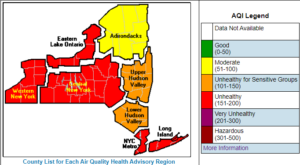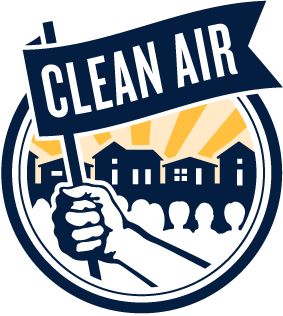Practical Safety Tips for Wildfire Smoke
 There is no such thing as a climate haven. No more sacrifice zones.
There is no such thing as a climate haven. No more sacrifice zones.
As the hazy, smoky air today proves, as a region we must take steps to not only reduce our carbon emissions (click here to send a letter to your reps calling on them to support the CCPF and NYHeat Act this week!) but also to mitigate the impacts that are already here.
Unfortunately, this shift will take time. Our leadership has failed to act fast enough, so we must organize as communities and individuals to protect ourselves.
Here are some practical tips you can follow and share with peers for reducing the health impacts of the wildfire smoke –
- Check on friends and family who may be more vulnerable to the smoke (IE, people with respiratory or cardiovascular conditions, seniors, and children.) Make sure medications are on hand and watch for signs of heart attacks. Check out today’s press release from Erie County DOH for more information.
- Be aware that wildfire smoke can also trigger anxiety attacks, which can feel very similar to an asthma attack, and feed into one another. If you find yourself breathing unusually hard, find a space with clearer air to take a break.
- Try to stay indoors as much as possible with windows closed and air conditioners set to recirculate/HVAC air intake systems shut off.
- Create a “Clean Room” in your home and office, where outside air is blocked off and an air filter is running. The EPA has guidelines here.
- Don’t have an air filter, but do have some leftover furnace filters, a box fan and some duct tape? You can DIY a Corsi-Rosenthal Box, which can reduce wildfire smoke by 75%!
- Bring pets inside. Small animals, especially birds, will be impacted by smoke before people will.
- If you do need to venture out, wear a mask, preferably an n95 or better.
- Safety googles will help reduce eye irritation. If you do not have safety goggles, saline or moisturizing eye drops will also help.
- Drink lots of water and take things slow.
- Skip the yardwork and outdoor exercise. Nothing strenuous outside!
At present, meteorologists with the National Weather Service are predicting that the smoke will diminish by Friday. So far, over 600 square miles have burned so far in Quebec, compared to a normal of 1 square mile for this time of year, so it is entirely possible we may see more smoke make it’s way south. We advise continuing to watch the AQI reports from NYS DEC and PurpleAir monitors. Wildfire smoke also persists in the atmosphere, so even if it’s no longer visible, the AQI may still be unhealthy. You can also track the predicted path of wildfire smoke plumes using this website.
We also encourage signing up for this Saturday’s Emergency Preparedness training, which will focus on summer weather risk. Click here to sign up now!
View this post on Instagram
RSS 2.0 feed. Both comments and pings are currently closed.
